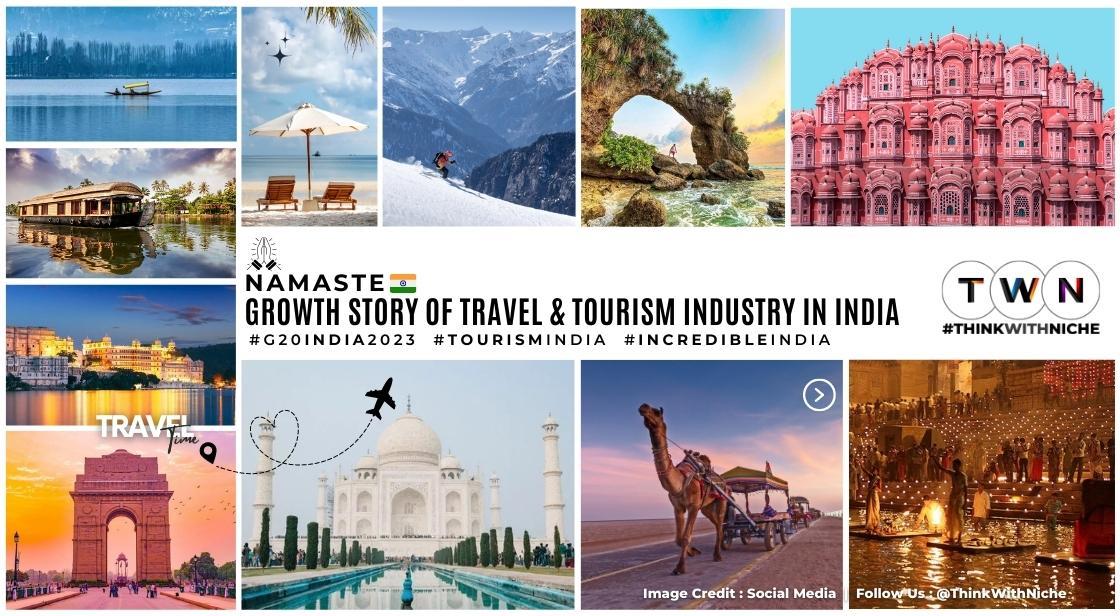Growth Story Of Travel And Tourism Industry In India

Blog Post
In India, the Ministry of Tourism is the primary institution in charge of formulating national policies and overseeing the development, administration, and promotion of the tourism industry. In order to promote tourism in the nation, the ministry works with both the public sector and the central government agencies.
According to latest figures on Indian tourism, this industry contributes 8.1% of employment and 9.2% of the nation's total GDP. India's tourist industry supported 39 million jobs in FY20; by 2029, that number is projected to rise to 53 million.
One of the key growth drivers for India's services sector has emerged as the tourism and hospitality sector. In India, tourism is a significant source of foreign exchange earnings. The foreign exchange earnings increased at a CAGR of 7% prior to the pandemic. India is ranked 10th by the Global Travel and Tourism Council in terms of the total GDP contribution of travel and tourism in 2019. 6.8% of the entire economy's GDP was made up of travel and tourism. 10.93 million foreign tourists (FTAs) visited India in 2019, representing a 3.5% annual growth rate and generating US$29.96 billion in revenue. FTAs are anticipated to reach 30.5 billion by 2028, bringing in approximately US$59 billion in income.
In light of the above information, this article will encourage you to learn more about the Growth Story Of Travel And Tourism Industry In India.
India has a diverse ecosystem, geography, and sites of natural beauty distributed throughout its 3,287,263 sq. km. total area, which stretches from the snow-covered Himalayan heights to the tropical rain forests in the south. This offers a crucial chance to fully realise the Travel And Tourism industry's potential.
Being one of the most popular vacation destinations in the world has led to India's tourism and hospitality sector becoming one of the major forces behind growth in the country's services sector. India's tourism industry has a lot of potentials since, like many other nations, it is a key source of foreign exchange. The foreign exchange earnings increased at a CAGR of 7% from 2016 to 2019, however, they decreased in 2020 as a result of the COVID-19 epidemic.
The Travel And Tourism industry, which includes travel and hospitality services like hotels and restaurants, is widely regarded to be a development agent, a catalyst for socioeconomic expansion, and a significant source of foreign exchange profits in many nations. Tourism not only promotes India's rich and beautiful history, culture, and variety, but it also has a big positive impact on the country's economy. The tourism industry has been able to bounce back from the shock of the COVID-19 pandemic and resume pre-pandemic operations thanks to the constant efforts of the federal and state governments.
Growth Story Of Travel And Tourism Industry In India
The importance of the Indian tourism industry:
India is a cosmopolitan melting pot and one of the oldest civilizations in the world. Due to its numerous attractions and vast history, the country is among the most popular tourist destinations in the world. India covers a land area of 3,287,263 sq. km, ranging from the snow-capped Himalayas in the north to the tropical rain forests in the south. Due to its diverse ecology and rich cultural heritage, the nation's tourism industry has experienced substantial growth. When it comes to contribution to Gross Domestic Product (GDP), India's tourist industry comes in eighth. The tourist sector in India generated US$ 247.3 billion in revenue in 2018, a 6.7% rise from the previous year and a contribution of 9.2% to the national economy. The industry was also among the top earners of foreign currency (FEEs).
Indian tourism industry growth
Several reforms were put into place in India to promote tourism after the COVID-19 outbreak; these measures have greatly boosted the industry. From January through July 2022, India's total FTAs increased by 406.6% to 2,764,975 over the previous year. The US was among the top 15 source countries during this time, contributing the most to FTAs in India with 25.88%, ahead of Bangladesh (18.61%), the UK (10.99%), and Australia (5.16%). India's tourist industry generated US$ 6.96 billion in foreign exchange in 2020. Following the pandemic, an increase in this is anticipated.
Also Read: Learn About The 10 New Production Linked Incentive Industries
Growth Factors for Indian Tourism
The number of FTAs in India has dramatically increased recently. There are a number of government policies and India-specific factors that may be responsible for this rise in FTAs. The following is a description of a few of the key growth factors.
Vaccination Drive:
India started its vaccination drive to protect the population against COVID-19 on January 16, 2021. The main objective of the initiative was to provide every citizen with free vaccinations. Around 200 crore vaccines were distributed in the first 18 months of this campaign, which was quite successful. This promoted India's liberalisation and improved its appeal as a safe tourist destination.
This promoted India's liberalisation and improved its appeal as a safe tourist destination.
Medical and Wellness Tourism:
India has one of the most affordable healthcare systems in the world, with top-notch physicians and facilities. The nation's wellness sector is well known on a global scale. Medical tourism in India has significantly increased thanks to the convergence of Eastern healthcare knowledge and Western medical know-how. In May 2022, the Indian government launched the "Heal in India" and "Heal by India" campaigns. The fundamental objective of these initiatives is to further develop the traditional medicine sector and turn India into a centre of the global medical business. India had 1.83 lakh FTAs for medical purposes as of 2020.
Increase in domestic travel:
After the pandemic, domestic travel in India increased significantly. Its expansion could be largely ascribed to rising disposable income and the expansion of the working class in India. When compared to corporate travel, the nation has seen more spending on leisure travel.
Governmental Initiatives for Indian tourism industry
The Indian government has recently come to understand how crucial tourism is for generating foreign cash and jobs. As a result, it has implemented a number of steps to promote both domestic and foreign travel, greatly assisting the travel and tourist industry. The following describes a few of these actions.
The Swadesh Darshan Scheme
The Ministry of Tourism introduced the Swadesh Darshan scheme, a flagship programme, in 2014–15. The programme strives to promote, advance, and maximise the tourist potential of India by encouraging theme-based travel. By March 2022, the Ministry of Tourism had approved over 76 projects totaling Rs. 5,500 crore (US$ 687.84 million) across 31 states and union territories. More than 500 tourist attractions also have infrastructure related to tourism that was created by the ministry. The government approved 10 additional projects in April 2022 with the heritage circuit theme.
National Integrated Database of Hospitality Industry (NIDHI)
NIDHI is an effort to help Aatmanirbhar Bharat empower businesses using technology. This programme tries to comprehend the geographic distribution, size, structure, and capability of the hospitality industry. There were 45,152 accommodations registered on this platform as of August 27, 2022.
E-tourist Visa
This project was introduced by the Indian government in October 2014. This programme intends to make it easier for foreign nationals to get a tourist visa. The country's tourism has benefited from this initiative's promotion. The government issued 2.36 million e-tourist visas in 2019.
Publicity Campaigns
Under its "Incredible India" campaign, the Indian government has encouraged tourism and highlighted the nation's rich cultural history to the world. The programme intends to promote Indian tourism on a global level. The government has launched a number of efforts in recent months to boost tourism. For instance, it introduced Amazing India Reconnect 2022, a virtual roadshow, in Italy to entice travellers from abroad to visit India. The Ministry of Tourism displayed various Indian tourism products in the Arabian travel industry in May 2022.
Interesting facts about India
- Indians developed the Harappan culture in the Sindhu Valley around 5000 years ago, when many cultures were still simply nomadic forest dwellers (Indus Valley Civilization)
- The River Indus, whose valleys the early immigrants called home, is the source of the name "India." The Indus River was referred to as the Sindhu by Aryan worshippers.
- In India, chess was first invented.
- Studies like algebra, trigonometry, and calculus have their roots in India.
- In India, around 100 B.C., the "Place Value System" and the "Decimal System" were created.
- India is the world's largest democracy, the seventh-largest nation, and home to one of the oldest civilizations.
- The first form of medicine that humans are aware of is Ayurveda. Ayurveda was unified by Charaka, the Father of Medicine, about 2500 years ago.
- The city of Cochin is home to India's oldest synagogue and church. In 1503 and 1568, respectively, they were built.
- Varanasi, often referred to as Benaras, is the oldest continuously inhabited city in the world and was called "the Ancient City" by Lord Buddha when he visited it in 500 B.C.
- Yoga has been practised for more than 5,000 years and has its roots in India.
You May Like
EDITOR’S CHOICE












